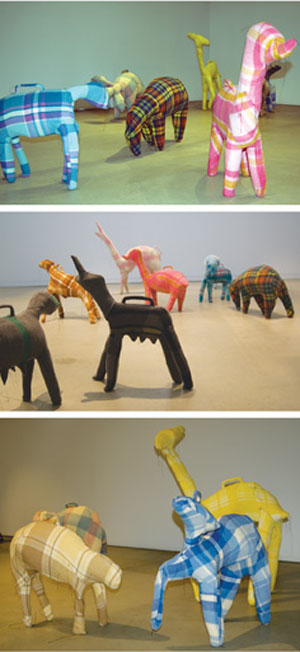
Handle Me Gently is a multi-faceted body of work that reveals a critical insight behind a fun and playful exterior. The room is populated by sixteen transgenic blanketed creatures, bizarre assemblages which are at the same time strangely familiar. Through these fantastic creatures adapted from her daughter's early line drawings, Cironis explores a dialogue which is iconic and primordial investigating notions of nurture versus nature, freedom and control. Reinterpreted within the artist's conceptual context and investigations into the human condition, this assortment of enigmatic forms raises a question - are they hybrids of nature or the result of human intervention?
The creatures effectively inhabit the exhibition space both as a single installation as well as individual pieces, a 'herd' of ideas. Their diverse size is intimate and toy-like and yet they retain an unnerving presence. In Handle Me Gently the dynamics of the original arrangement are not fixed. Audience involvement becomes an essential part of the experience. On entering the space, three of the creatures have heard your approach and face you meekly but with an underlying sense of defiance. The rest are milling around the space engaging with each other. In the first instance, the random display of the animals forces the audience to make a choice - meandering through the space experiencing the creatures in their 'natural habitat' or randomly manipulating their position and physical interaction.
Each creature features a handle located somewhere on its body.The audience is invited to relocate them throughout the room creating an ever-changing dialogue between audience, objects and space. The only creature that is not movable is a somewhat disturbing piece which resembles part of an amorphous grey and white trunked creature. The handle has been placed at the end of the trunk which hangs limp on the floor like a leash. It's a lifeless trophy, a conquered beast, a reminder of our ability to overpower and dominate nature.
As devices to engage the audience the handles are also symbols of possession and control. Cironis questions humanity's attempt to manipulate the spirit of nature for our own needs and greed. Irony and humour is evident in the position of the handles on the creatures. Although some appear located so as to easily allow the work to be lifted and moved, the subtle changes in the creatures' centre of gravity and distribution of weight due to their unnatural forms makes this an uncomfortable act, making many difficult to carry. Upon clutching the handle we get the perception of being in charge, but upon lifting the object the fallacy is revealed, we are not in control after all.
The blankets used to cover the creatures are symbols of sleep, nurturing, of the unconscious and childhood memories and have been central in Cironis' installation practice to date. Found or acquired second-hand each blanket's design has its own character and history; the styles and patterns speak of different age groups and gender. While none of the creatures have names, just numbers, Cironis is clear about refusing to consciously invest them with constructed personas, human traits and behaviours, the blankets, the creatures' forms and their stances come together to invest each one with a distinct personality. Interestingly, one of the more subtle and unintentional 'clusters' in the exhibition is a group of young creatures, all of which are grey with only a hint of colour, symbols of an undefined blank or neutral canvas.
The exhibition speaks loudly of humanity's need to control the environment it inhabits, to manipulate it and possess it. It questions our vision of normality by exploring the humour and innocence of youth, how we progressively become regimented by conventions and logic and how we succumb to life and its perceived restrictions and controls.












